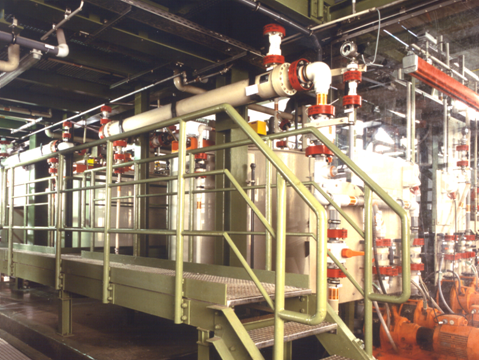Products
RODUCTS
PAcid Microfiltration
The Steuler Acid Microfiltration (SAM) is mainly used for the filtration of mixed acid (HF/ HNO3),HF/H2SO4 and HCl, and has already been well-proven in approximately 20 reference systems for 20 years.
and HCl, and has already been well-proven in approximately 20 reference systems for 20 years.
Using this process the insoluble solids accumulated in the pickling solution are separated by continuous microfiltration and concentrated.
The objectives of the solid separation are:
— the removal of the particles from the pickling bath - thus the sedimentation of solids, the deposit and
accumulation of mud in the pickling bath are reduced-consequently often plant shutdowns necessary
for cleaning the pickling baths are avoided and the consumption of acid is reduced
— the production of an absolutely solid-free filtrate that can be further used in a downstream process
stage for cleaning the free acid or regenerating the total acid
Process description:
The complete homogenization of the particles contained in the pickling bath is a pre-condition for the separation of solids by means of filtra-
tion in a separate microfiltration cycle.Therefore we use different circulation cycles and injectors in the strip and wire coil pickling lines. Due to
a continuous mixing of the pickling baths the homogenized solids in the pickling solution are supplied to the microfiltration system in a partial stream. One or more cross-flow-microfiltration modules are the principal parts of this separating stage where the pickling solution is pressed through the membrane at high speeds. The solids are completely retained at the surface of the membrane, strongly accumulated in the cycle
and drained with a small partial stream. Because of the hydraulic design and periodic backwashing the service life of the used acid-resistant microfiltration membranes is very long.
The plants are constructed in modular design and designed according to amount of the accumulated solids or to the filtrate flows that are re-
quired for the downstream acid purification/recovery.
Furthermore the design of the plants complies with the respective technical requirements/standards: At high pickling acid temperatures either
a single-stage heat exchanger for cooling by cooling water or a double-stage heat exchanger can be installed. When using the latter, cooling
is carried out in the first heat exchanger stage with the filtrated pickling solution by heat recovery, so that only a small cooling water quantity
is needed in the second stage.
The operation of the microfiltration system along with the periodical backwashing is fully automated. This includes the required rinsing of the filtration cycle in case of plant shutdowns, the maintenance or failures as well as rinsing of the acid feed and drain pipes. This high process automation as well as the operation and documentation via the central processing unit (CPU) are the main features ensuring a user-friendly design and operation of the plant.
When using an acid purification/ recovery downstream to the microfiltration systems, it is useful to concentrate the solids further in order to minimize the loss of free acid in the flow to be drained. This is achieved by thickening the pre-concentrated suspension in filtration by means
of sedimentation or hydro cyclone stages.
The main benefits in sum are:
— finest particles in the µm range are separated completely at high solid concentrations
— all used materials and diaphragms are acid-resistant
— the modular design makes it possible to retrofit the plant and increase the capacities subsequently
— high process automation and user-friendly design in order to reduce the personnel costs at the job-site the standardized plant parts can
be pre-assembled